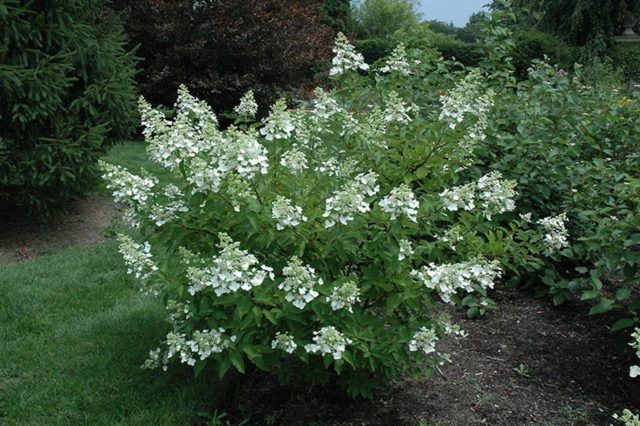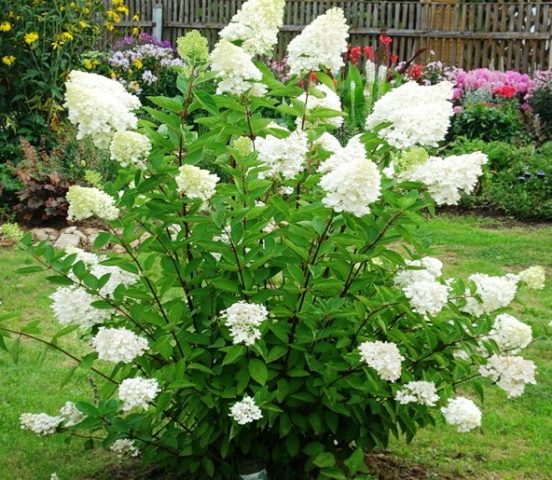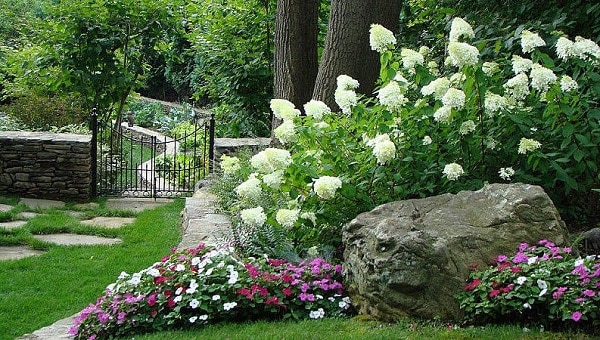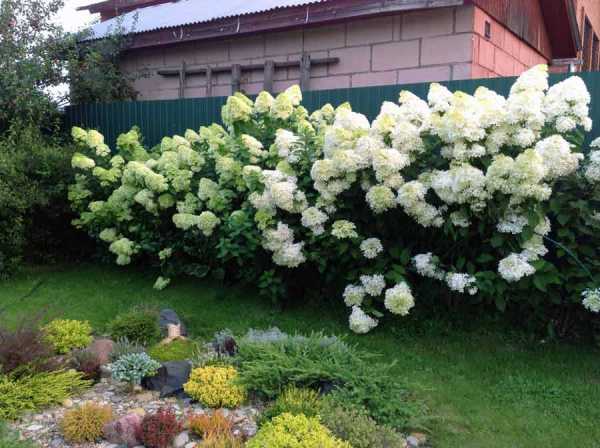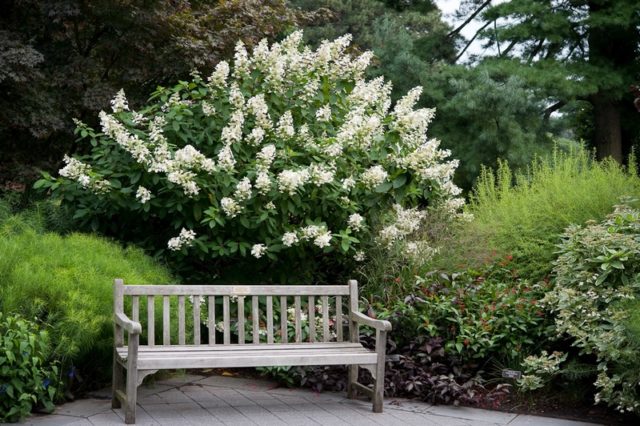Content
Many beautiful varieties of hydrangeas are successfully grown in various regions of Russia, despite the harsh winters and dry summers. One of the striking examples is Levan's hydrangea. This is a very beautiful bush with a lush, compact crown and large white flowers, collected in numerous inflorescences. It is successfully grown on rather acidic, fertile soils. Responsive to regular watering and monthly fertilization.
Description of Levan's hydrangea
Levan's hydrangea is a type of panicle hydrangea, which is valued not only for its high decorativeness, but also for its pleasant aroma, reminiscent of the smell of honey. Under favorable conditions, the bush reaches a height of 2.5-3 m. Hydrangea forms a very dense, compact crown with abundant white and milky-cream inflorescences.
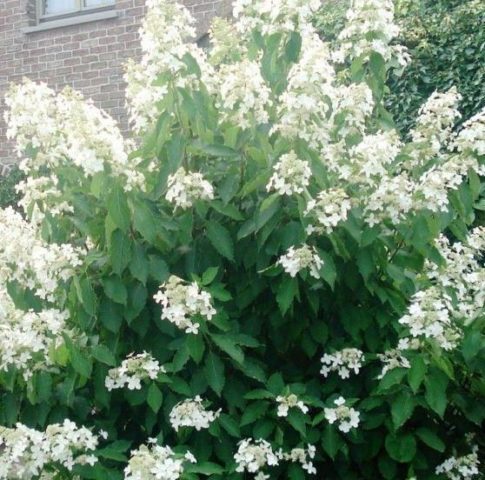
Levana's hydrangea flowers are clearly visible against the background of bright greenery
The peculiarity of the plant is its large flowers, which reach a diameter of 5-6 cm, which is 2 times higher than that of many other varieties (for example, Pinky Winky). Despite its large size, the bush does not fall apart even from strong winds. It does not require a support or a garter. It is enough to carry out timely pruning, organize regular watering and feeding.
Hydrangea Levan in landscape design
A large, sprawling bush can decorate any garden. Hydrangea Levan is used in both single and group plantings. It looks beautiful both in the center of the garden and around its edges. Often the plant is placed along the house, right next to the entrance or not far from the paths. Here are some examples of how Levan's hydrangea can be used in landscape design:
- Due to their high decorative effect, the bushes look good in single plantings against the backdrop of a lawn.
- Levan's hydrangea can be planted right in the center of the lawn - it can be a lonely bush or rows of plants.
- This hydrangea goes well with other flowers. Since they are usually several times lower, it is worth placing them in the foreground.
- Levan's hydrangea, planted along the fence, looks good.
- This lush bush should be planted somewhere in a special place in the garden, for example, next to a bench.
Winter hardiness of hydrangea Levan
A special advantage of the Levana hydrangea is its high winter hardiness. Adult bushes can even endure extreme frosts with temperatures of -30 degrees and even up to -35. Despite the fact that young shoots die in such conditions, the bush itself quickly recovers. Therefore, it is possible to breed Levan's hydrangea not only in the Middle Lane, but also in the regions of the Urals, Siberia and the Far East.
In the Moscow region, in the south, in the regions of Central Russia, Levan's hydrangea does not need additional shelter - it is enough just to mulch the roots for the winter. It is better to cover young shoots additionally, especially in regions with frosty winters.
Planting and caring for Levan's hydrangea
The Levana variety can be looked after in about the same way as the rest of the hydrangea varieties. The main requirement is to ensure the correct planting site, regularly water, feed and prune the bush as necessary.
Selection and preparation of the landing site
Hortense Levana loves lighting, but at the same time tolerates places with weak shadow well. When choosing a place on the site, you can pay attention to the following recommendations:
- The abundance of sunlight is bad for the plant, so it is better to plant it in the shade of trees, shrubs or buildings.
- It is better to choose a place from the south or southeast part of the house or other buildings, so that the presence of shade is compensated by constant light in the morning.
- The bush does not like constant winds and drafts. Therefore, it is advisable to choose a protected place in the garden - along the fence, next to the house or large trees, a strip of shrubs.
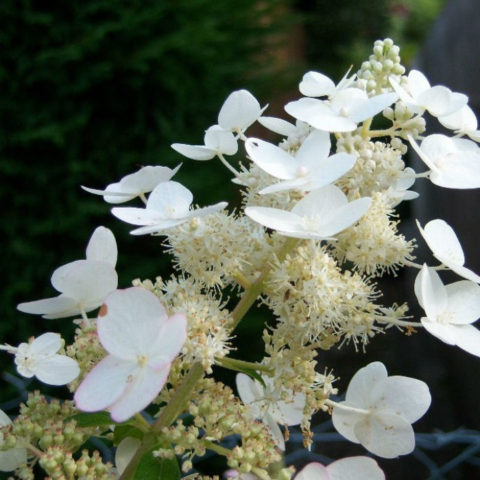
Shrubs like lighted places, without strong shade all day long
Landing rules
The bush loves a fairly fertile, light soil. The optimal soil composition for hydrangea is as follows:
- sheet land (2 parts);
- humus (2 parts);
- peat (1 part);
- sand (1 part).
The landing algorithm is as follows:
- Dig a hole with the same diameter and depth of about 50 cm.
- Pour water over it: 2-3 liters.
- They make up a mixture of soil of the described composition, fall asleep in a pit.
- The seedling is placed in the center, covered with earth to the root collar.
- Sprinkle again with plenty of water (1 bucket).
- Then the roots are mulched with natural material - needles, compost, peat. The layer is left for the whole summer.
Watering and feeding
Hydrangea Levan, like other varieties, is very fond of moisture. Therefore, compliance with the watering regime is mandatory. You can act like this:
- If there is enough rainfall (moderate or heavy rains), you can additionally water the bush once a month.
- If there is little rain, at least 1 time per week.
- If there is a prolonged drought, it is better 2 times a week.
In all cases, 15-20 liters of water is enough for 1 adult bush. Young seedlings can be given 5 liters.
Top dressing is applied every month:
- First time at the beginning of the season (April) - nitrogen compounds (you can use inorganic or organic fertilizers).
- Second, third time (June, July) - potash and phosphate fertilizers. The first time they are added at the stage of bud formation.
- The fourth (last) time is the end of August. You can also add potassium or phosphorus: then Levan's hydrangea will continue to bloom in September.
After that, no additional fertilizing is necessary - the bush must prepare for the period of winter dormancy.

To ensure the lush flowering of Levan's hydrangea, fertilizers must be applied monthly, and even more often on depleted soils.
Pruning hydrangea Levan
Pruning the hydrangea is a must, as the shoots grow quickly and the bush can lose its attractive shape as a result. The haircut is carried out several times per season:
- The main pruning is in March, before the juices start moving. Remove all damaged, ugly branches that clearly spoil the shape. Thin out the dense part of the crown - it is necessary to remove the shoots growing inward and to the sides (while leaving 2-3 buds).
- At the stage of bud formation, it is advisable to remove weak branches with inflorescences. Then the rest of the shoots will give even more lush flowers.
- In the fall, you can again remove all unnecessary branches so that the crown remains orderly and beautiful.
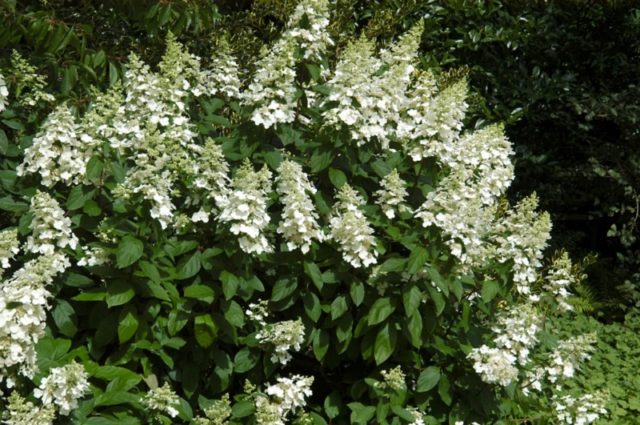
Thanks to timely pruning, the bush will always look attractive
Preparing for winter
Special preparation for winter is not required, since Levan's hydrangea tolerates even extreme temperatures well. Therefore, in the fall, it is enough to carry out only mulching, spreading a layer of peat or sawdust with a height of 6-7 cm. It is recommended to maintain the same layer throughout the summer. It protects the soil from the rapid loss of moisture, which eliminates the need for too frequent watering.
Reproduction of hydrangea Levan
You can breed this bush in any convenient way:
- seeds;
- layering;
- by cuttings.
The easiest option is to get a new hydrangea using green cuttings. The instruction is simple:
- In June or in the first half of July, the apical cuttings with 2 or 3 pairs of leaves are cut.
- The bottom pair is removed, the rest are cut in half.
- The stalk is soaked in "Epin" for 1 hour (concentration 1 ml per 2 l).
- Planted in wet sand at an angle of 45 degrees, watered with water and covered with a jar.
- Watered regularly, at the end of summer they are transferred to containers with ordinary soil.
Then the cuttings overwinter indoors, after which they can be transferred to open ground after the snow melts (March-April).
Diseases and pests
The Levan variety is affected by the same diseases and pests as other varieties of hydrangea. However, with proper care and prevention, the bush will certainly be able to save it from unpleasant symptoms.
The following diseases are most often observed:
- chlorosis;
- gray rot;
- powdery mildew;
- leaf spot.
Various pests can often be found on the leaves of the bush;
- aphid;
- spider mite;
- leaf roll.
To prevent diseases, it is necessary to ensure regular watering, feeding, as well as treatment with fungicides and insecticides according to the instructions. For prevention, you can also use folk remedies (solution of ash, soda and other methods).
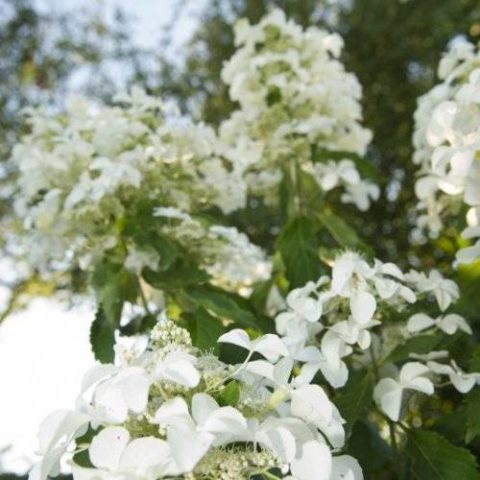
Gardeners should periodically inspect the bush for fungal infections and pests.
Conclusion
Hydrangea Levana is one of the varieties that is well suited for almost any region of Russia. It is a decorative, tall, attractive shrub with large white flowers. Subject to the regime of watering and applying dressings, both an experienced and a novice gardener will be able to cope with its cultivation.
